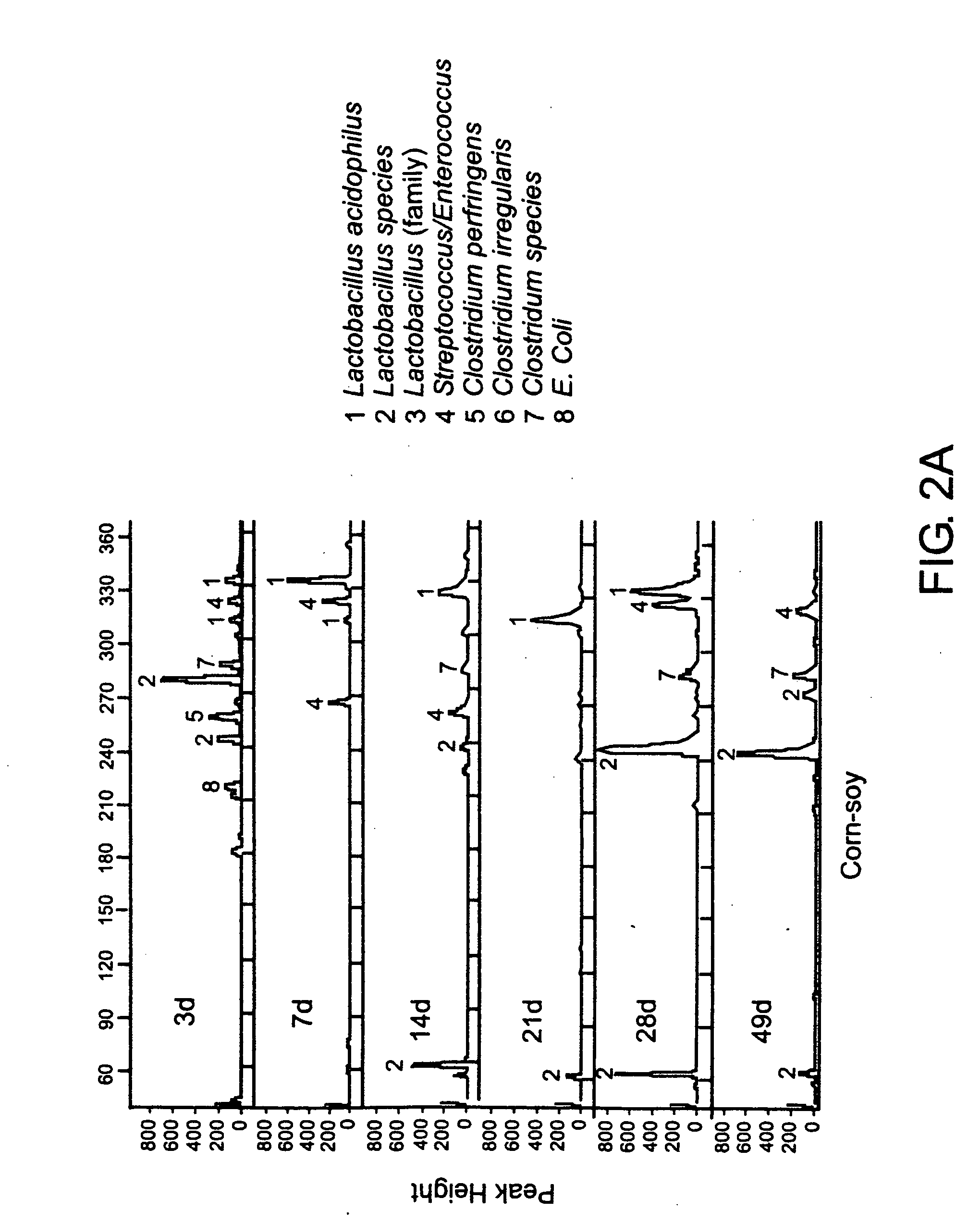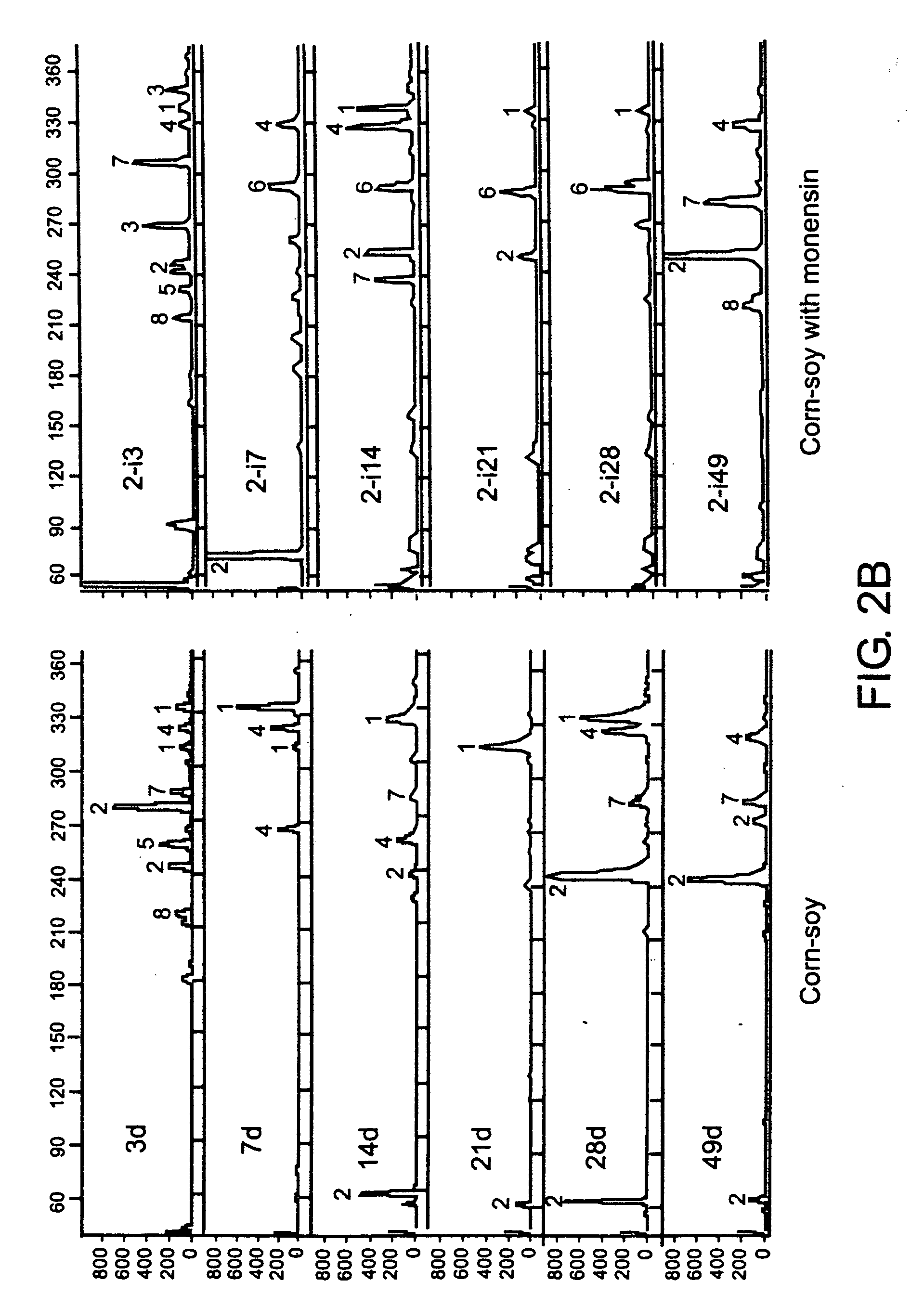Probiotic bacteria and methods
a technology of probiotic bacteria and methods, applied in the field of agriculture, can solve the problems of no alternative means to replace economic advantages, the removal of antibiotics without a suitable substitute, and the negative impact on the animal production industry
- Summary
- Abstract
- Description
- Claims
- Application Information
AI Technical Summary
Benefits of technology
Problems solved by technology
Method used
Image
Examples
example 1
Sampling
[0052] Sixty day-of-hatch commercial leghorn-hybrid broiler chicks, placed on sawdust bedding, were used as the source of bacteria for DNA extractions. Chicks were fed ad libitum commercial corn-soy diet that did not contain growth-promoting antibiotics or coccidiostats. Ten chicks were sacrificed at 3 and 7 days of age, and then the ileal contents were removed and pooled. At 14, 21, 28, and 49 days of age, 5 chicks per age were sacrificed and their ileal contents pooled. The ileum was cut aseptically, and contents were removed to 3 ml tubes containing brain heart infusion broth (BHIB) kept on ice, and processed for bacterial recovery. The contents from the individual birds were pooled to provide a composite sample prior to bacterial fraction recovery, cell lysis, and DNA isolation.
example 2
Recovery of Bacteria, Cell Lysis and DNA Isolation
[0053] The bacterial fraction was recovered from the ileum contents through multiple rounds of dilution, high speed centrifugation, and washing with PBS as described previously (Apajalahti et al. 1998, supra). The bacteria were pelleted by a high-speed centrifugation (3,650×g for 15 min.), re-suspended in superbroth (Provence, D. L., and R. Curtiss III, 1994, “Gene transfer in gram-negative bacteria,” pp. 317-347. In P. Gerhardt, Ed., Methods in General and Molecular Bacteriology, ASM Press, Washington D.C.) with 15% glycerol and stored at −80° C. Bacterial cells were lysed using the beads and solution 1 and IRS of Mo Bio kit (Mo Bio Laboratories Inc., Carlsbad, Calif.) by beating at 6000 rpm for 20 min. Genomic DNA was extracted as follows: lysed cells were treated with SDS (0.5%, final concentration), and proteinase K (0.1 mg ml−1, final concentration) and incubated at 37° C. for 30 min. The sample was extracted twice with an equa...
example 3
PCR for Construction of 16S rDNA Clone Libraries
[0054] For construction of the 16S rRNA gene clone libraries, three sets of primers, which target the domain Bacteria were used (Hicks et al. 1992). These were (1) 8F, (5′-AGA GTT TGA TCC TGG CTC AG-3′) / 1492R (5′-TAC GGY TAC CTT GTT ACG ACT T-3′); SEQ ID NO:12 and SEQ ID NO:13, respectively, (2) 8F / 1522R (MG GAG GTGATC CAN CCR CA) and (3) 8F / 926R (ACC GCT TGT GCG GGC CC) SEQ ID NO:14 and SEQ ID NO:15, respectively. Y represents C or T, R A or G, and N is A or G or C or T. Primer 1492R contains a single degeneracy, which is between T and C at position 1497 (E. coli numbering). The first two primer sets are frequently used in molecular diversity studies because they result in a nearly full-length 16S rDNA product and are considered universal for the domain Bacteria, and for the prokaryotes (domains Archaea and Bacteria, respectively) (Lane, D. J. 1991, 16S / 23S rRNA sequencing, p115-175. In E. Stackebrandt and M. Goodfellow (ed), Nucleic...
PUM
| Property | Measurement | Unit |
|---|---|---|
| concentration | aaaaa | aaaaa |
| volume | aaaaa | aaaaa |
| volume | aaaaa | aaaaa |
Abstract
Description
Claims
Application Information
 Login to View More
Login to View More - R&D
- Intellectual Property
- Life Sciences
- Materials
- Tech Scout
- Unparalleled Data Quality
- Higher Quality Content
- 60% Fewer Hallucinations
Browse by: Latest US Patents, China's latest patents, Technical Efficacy Thesaurus, Application Domain, Technology Topic, Popular Technical Reports.
© 2025 PatSnap. All rights reserved.Legal|Privacy policy|Modern Slavery Act Transparency Statement|Sitemap|About US| Contact US: help@patsnap.com



